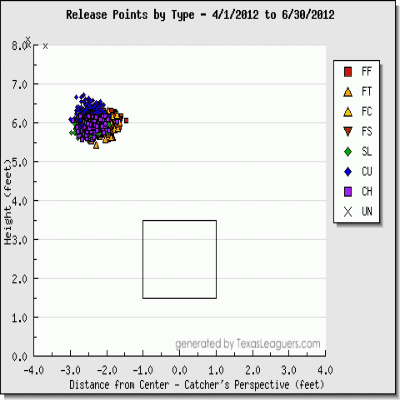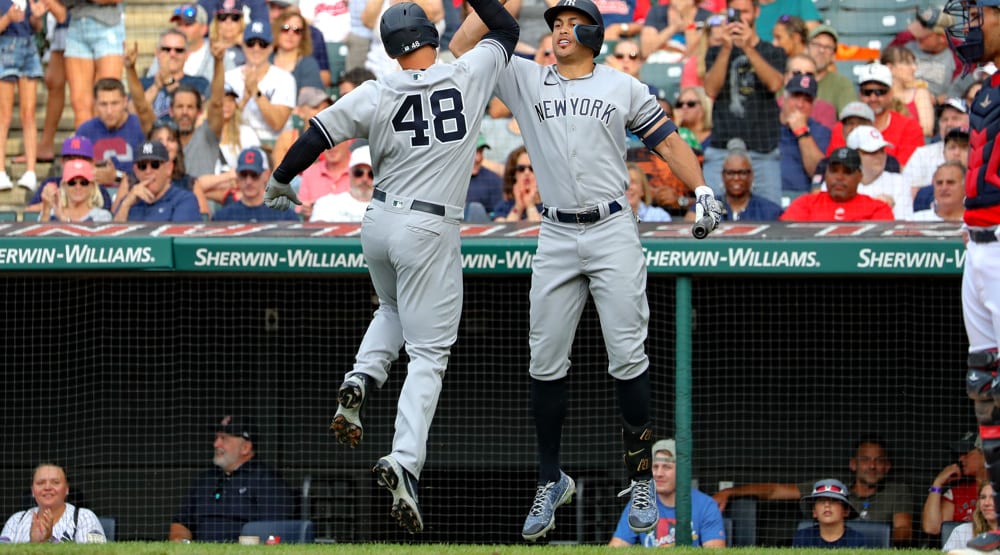3.69. 3.23. 3.37...
Plenty of strikeouts and fewer walks than the typical starting pitcher. Something changed, and the ball wasn't missing the bat nearly as often, but it still seemed as though he was being cheated in the results.
3.55, 4.17 and now, 3.96.
Over the last six seasons, Ricky Nolasco has had an xFIP above 4.00 exactly once. Prior to his first eight starts in 2013, his ERA has not been lower than 4.48 since 2008.
Now 30 years old and on one of the worst major league teams ever assembled, he's quietly providing value with two wins, a 3.72 ERA and 1.16 WHIP.
Over the last three seasons, little has changed in his strikeout and walk rates:
2011: 6.47 K/9, 1.92 BB/9, 16.6% K%, 4.9% BB%
2012: 5.89 K/9, 2.21 BB/9, 15.0% K%, 5.7% BB%
2013: 6.33 K/9, 2.05 BB/9, 17.0% K%, 5.5% BB%
The important question of course, has anything changed in his skill set or approach?
Let's start with Nolasco's pitch selection (data from Brooks Baseball)
| Pitch | 2010 | 2011 | 2012 | 2013 |
| Fourseam (FA) | 42% | 34% | 25% | 22% |
| Sinker (SI) | 8% | 17% | 21% | 26% |
| Slider (SL) | 24% | 26% | 23% | 20% |
| Slow Curve (CS) | 15% | 13% | 16% | 18% |
| Splitter (FS) | 11% | 10% | 14% | 14% |
| Curveball (CU) | 1% | 0% | 1% | 0% |
3.69. 3.23. 3.37...
Plenty of strikeouts and fewer walks than the typical starting pitcher. Something changed, and the ball wasn't missing the bat nearly as often, but it still seemed as though he was being cheated in the results.
3.55, 4.17 and now, 3.96.
Over the last six seasons, Ricky Nolasco has had an xFIP above 4.00 exactly once. Prior to his first eight starts in 2013, his ERA has not been lower than 4.48 since 2008.
Now 30 years old and on one of the worst major league teams ever assembled, he's quietly providing value with two wins, a 3.72 ERA and 1.16 WHIP.
Over the last three seasons, little has changed in his strikeout and walk rates:
2011: 6.47 K/9, 1.92 BB/9, 16.6% K%, 4.9% BB%
2012: 5.89 K/9, 2.21 BB/9, 15.0% K%, 5.7% BB%
2013: 6.33 K/9, 2.05 BB/9, 17.0% K%, 5.5% BB%
The important question of course, has anything changed in his skill set or approach?
Let's start with Nolasco's pitch selection (data from Brooks Baseball)
| Pitch | 2010 | 2011 | 2012 | 2013 |
| Fourseam (FA) | 42% | 34% | 25% | 22% |
| Sinker (SI) | 8% | 17% | 21% | 26% |
| Slider (SL) | 24% | 26% | 23% | 20% |
| Slow Curve (CS) | 15% | 13% | 16% | 18% |
| Splitter (FS) | 11% | 10% | 14% | 14% |
| Curveball (CU) | 1% | 0% | 1% | 0% |
From here, it's important to gauge the effectiveness of the adjustment by looking at the results of each offering on a year-by-year basis.
| Year | Pitch | AB | SO | BB | HR | BA | SLG | ISO | BABIP |
| 2010 | Fourseam (FA) | 204 | 43 | 20 | 13 | 0.363 | .662 | .284 | .412 |
| 2011 | Fourseam (FA) | 240 | 29 | 21 | 7 | 0.329 | .525 | .183 | .353 |
| 2012 | Fourseam (FA) | 153 | 17 | 12 | 7 | 0.346 | .588 | .216 | .357 |
| 2013 | Fourseam (FA) | 27 | 4 | 3 | 0 | 0.259 | .407 | .111 | .304 |
| Year | Pitch | AB | SO | BB | HR | BA | SLG | ISO | BABIP |
| 2010 | Sinker (SI) | 40 | 0 | 2 | 0 | 0.350 | .525 | .150 | .350 |
| 2011 | Sinker (SI) | 135 | 2 | 6 | 3 | 0.393 | .556 | .148 | .385 |
| 2012 | Sinker (SI) | 162 | 13 | 16 | 4 | 0.340 | .481 | .142 | .352 |
| 2013 | Sinker (SI) | 52 | 7 | 7 | 3 | 0.269 | .481 | .212 | .262 |
But why didn't the results improve already?
Players do not develop linearly – and in the case of pitchers, the loss of velocity often forces adjustments that can take time to fully materialize in an effective way. Michael Barr wrote a piece for Fangraphs in November that, based on the title, I was expecting to highlight some sort of odd favorable road splits, but instead it showed a change in his release point during the second half of the season.
In Barr's piece, it was determined that Nolasco – for one reason or another – appeared to change his arm slot on the fly in 2012, at some point around midseason. His horitzonal release point was closer to his body from July on. So, where has he been for the first eight starts this season?
The following graphic shows Nolasco's release points in each half of 2012, as well as his first eight starts for 2013:

Put simply, maintaining a consistent release point goes a long way in determining a pitcher's ability to reliably locate his offerings.
What does it all mean?
Realistically, we're still talking about a pitcher who from a mixed-league standpoint in particular, leaves a lot of to be desired with his low strikeout rate. However, Nolasco has always possessed good control and now he's pitching half of his games in a one of the league's more pitcher-friendly home parks (subject to change as a likely midseason trade chip, of course).
Here are the concerns. Nolasco's swinging-strike rate is down to a career-low 7.2% in 2013, and he's getting hitters to chase pitches outside the zone at his lowest clip (26.7%) since 2007. Opposing hitters are not being fooled often, but perhaps that is less important to Nolasco than it has been in previous seasons.
The Marlins' defense ranks 12th in team efficiency in 2013 – after checking in at 23rd in 2012, 17th in 2011 and 24th in 2010. Particularly for a pitcher incapable of avoiding contact, it's important to have steady defenders around the field. For everything the Marlins might lack offensively, they seem to have a more competent set of gloves supporting the staff thus far – on an individual level the defensive upgrade to Adeiny Hechavarria at shortstop is a big one – especially when you consider some of the options the Marlins have trotted out to the left side of the infield in recent seasons including Hanley Ramirez, Greg Dobbs, Wes Helms and Jorge Cantu.
Same old Nolasco? Mostly. Same old Marlins defense? Maybe not, and that should give him at least a chance of closing a small portion of the gap between in his xFIP and ERA.


























